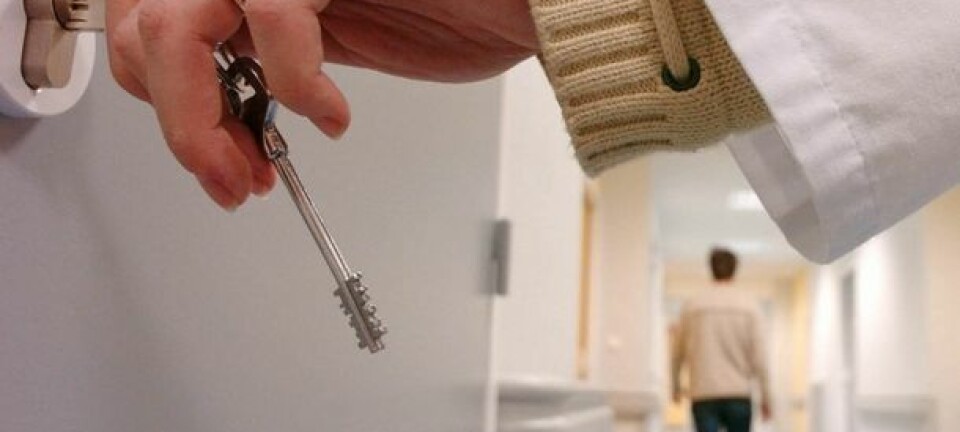This article was produced and financed by Oslo Metropolitan University
Digital aids are not helpful for all patients
The health service uses a growing amount of technology for communicating with patients. While this works well for some cancer patients, it can lead to others becoming unduly preoccupied with their illness.
Denne artikkelen er over ti år gammel og kan inneholde utdatert informasjon.
Digital aids may be of great assistance to patients who are not hospitalized.
Instead of saving questions for hospital visits, the patient can any time send messages to a medical professional – and quickly receive an answer. The tool also enables a more efficiently mapping of the patient’s symptoms, and it can be helpful for the patients to obtain advice and to find quality-assured information on their condition. Furthermore, the patients can join an online forum for people in the same situation.
It all sounds great. But is this kind of patient care really suitable for everyone?
Affect in different ways
Gro Hjelmeland Grimsbø at Oslo and Akershus University College of Applied Sciences has studied the effects of one such solution called WebChoice.

She recently defended her thesis dealing with how cancer patients living at home use and experience the programme.
"Health personnel who want to use technology tools for communicating with their patients must be made aware that these tools affect patients in different ways – for better or worse," says Hjelmeland Grimsbø.
"It is clear that having a direct line between home and the health service does something with the patient's experience of illness, of the health service, and of relationships to others in both positive and more challenging ways," she continues.
Consequently, these tools do not suit everyone.
“This is important to emphasise, particularly in light of the health authorities' growing reliance on technology tools in modern patient care," the researcher says.
569 emails
Hjelmeland Grimsbø studied 569 emails between 60 patients with breast cancer or prostrate cancer and five cancer care nurses working for WebChoice.
She also interviewed 10 patients using the service.
This gave Hjelmeland Grimsbø insight into what questions and concerns home-care patients have while undergoing treatment for cancer.
She also looked at how the nurses communicate with the patients via electronic messages and at patients' experiences of using a technology tool from home while sick.
During the interviews, it emerged that using WebChoice from their homes could make patients feel calm, normalised, supported and give them a sense of community.
However, some patients found that the tool gave them a sense of uncertainty and vulnerability and made them more preoccupied with their illness than they would like to be.
For those who used WebChoice frequently, it became a friend and a source of support, whereas for those who used it rarely, the internet service became an alien element in their lives.
Strong need for support
Hjelmeland Grimsbø's study also shows that home-care patients undergoing active treatment for cancer have many serious questions and concerns.
"They wrote a lot about living with the symptoms and side effects of their cancer treatment, which shows that this was important for the patients to receive help and support for," says Hjelmeland Grimsbø.
Different concerns between the sexes
The women with breast cancer were particularly concerned about feelings of tiredness and fatigue.
The main concerns of the men dealt with issues of sexuality, impotence, and incontinence.
The patients also demonstrated a need for the nurses to confirm that their symptoms were normal rather than signs of deterioration or relapse.
"Health personnel have room for improvement here, and we must pay more attention to the patient's experiences of the side effects of cancer treatment," says Hjelmeland Grimsbø.
Other things that emerged in the messages to the cancer care nurses were the patients' strong fear of relapse and their uncertainty about what they could do in terms of everyday activities.
"Many patients expressed a sense of living in a vacuum during and after their cancer treatment, where their need for information was not always fully met in their normal contact with the health service," says Hjelmeland Grimsbø.
Identified patient concerns
The nurses in the study managed to identify and respond to many of the patients' concerns in an empathetic and informative way via email communication.
"This may suggest that the nurses have more time to capture concerns, to respond to them, and to reflect on them when using an electronic question and answer service," says Hjelmeland Grimsbø.
"Moreover, it may be that patients' concerns are more easily identifiable in text than in more fleeting consultations in the health service," says Hjelmeland Grimsbø, adding that a lot of caring, emotions, and empathy also flowed freely in textual form.
"Nevertheless, it's important to state that email communication can never replace human contact in the health service, though offering the option of communicating by email with nurses to supplement regular follow-up may be one way of providing support to cancer patients."
Reference:
Gro Hjelmeland Grimsbø: "The final question cannot be answered by anyone anyway... Cancer patients’ use of and experiences with an Interactive Health Communication Application (IHCA) during treatment and rehabilitation for cancer". PhD thesis, Oslo and Akershus University College of Applied Sciences, Faculty of Health Sciences, January 2014.
------------
Read the Norwegian version of this article at forskning.no





































